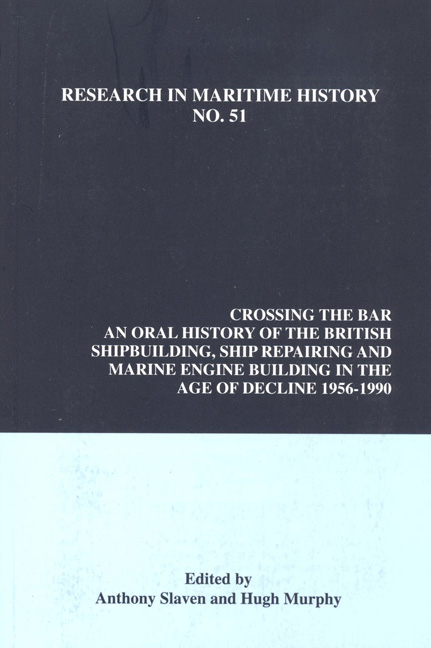 Crossing the Bar
Crossing the Bar Book contents
- Frontmatter
- Contents
- About the Authors
- Dedication
- Preface: A Shipbuilding Libretto
- Introduction
- Interviews
- Lower Clyde
- Upper Clyde
- The Tyne
- The Wear
- Barrow-in-Furness
- The South Coast
- The Humber
- Belfast
- 30 Dr. Denis Rebbeck, Harland and Wolff
- 31 T. John Parker, Harland and Wolff, Austin and Pickersgill, British Shipbuilders Plc
- 32 Eric Mackie, Harland and Wolff Ship Repairers, British Shipbuilders Plc
- British Shipbuilding Industry Officials
- The Trade Unions
- The Civil Servants, Board of Trade, Shipbuilding Enquiry Committee, Shipbuilding Industry Board, Ministry of Technology, Department of Trade and Industry, Department of Industry
- The Politicians
- Interviews British Shipbuilders Plc
- Conclusion
- Select Bibliography
30 - Dr. Denis Rebbeck, Harland and Wolff
from Belfast
- Frontmatter
- Contents
- About the Authors
- Dedication
- Preface: A Shipbuilding Libretto
- Introduction
- Interviews
- Lower Clyde
- Upper Clyde
- The Tyne
- The Wear
- Barrow-in-Furness
- The South Coast
- The Humber
- Belfast
- 30 Dr. Denis Rebbeck, Harland and Wolff
- 31 T. John Parker, Harland and Wolff, Austin and Pickersgill, British Shipbuilders Plc
- 32 Eric Mackie, Harland and Wolff Ship Repairers, British Shipbuilders Plc
- British Shipbuilding Industry Officials
- The Trade Unions
- The Civil Servants, Board of Trade, Shipbuilding Enquiry Committee, Shipbuilding Industry Board, Ministry of Technology, Department of Trade and Industry, Department of Industry
- The Politicians
- Interviews British Shipbuilders Plc
- Conclusion
- Select Bibliography
Summary
My father [Sir Frederick Rebbeck, Chairman and Managing Director] was in Harland and Wolff from about 1905 to 1962 when he retired. He was anxious that I went into the company because he said it was a great industry and a great firm. I went up to Cambridge and did the Mechanical Sciences Tripos so I came in the engineering side and not the shipbuilding side of Harland and Wolff, and then served an ordinary apprenticeship. I went on to the Board in 1946, and was the only Director of twelve who had any academic qualifications, and in 1962 I became Managing Director.
If we start the story for me around the early 1930s it is worth saying that the yard was down to a mere 1200 men, and it was nearly falling off the precipice. The other shipyard in Belfast [Workman Clark] which had also headed the output of the world on a number of occasions had gone bust in 1928, was revived, and went on again until 1935 before going bust for the last time. When the Admiralty placed a cruiser contract with us in 1934, we started up again. Further orders came in, and as war requirements developed, the yard did extremely well. In 1941, the Luftwaffe came up from Northern France and flattened us. We were sixty percent wiped out. That was a terrifying blow, there were a thousand people killed in Belfast. The yard had to rebuild and get going again as best as it could. We lost a wonderful opportunity to put in bigger cranes etc, as the Admiralty ordered us to put everything back as it was because that was the quickest way back into production. We put back in the cranes that had been installed in 1913. Our total war output was ten percent of the total UK output, so we were important. We were also important to the city of Belfast as we employed 30,000 men. We really established ourselves as the largest shipbuilders in the world. Post-war, the work requirements were enormous due to all the sinking of ships. At one stage, we had four and a half years of orders on our books.
- Type
- Chapter
- Information
- Crossing the BarAn Oral History of the British Shipbuilding, Ship Repairing and Marine Engine-Building Industries in the Age of Decline, 1956-1990, pp. 129 - 133Publisher: Liverpool University PressPrint publication year: 2013
